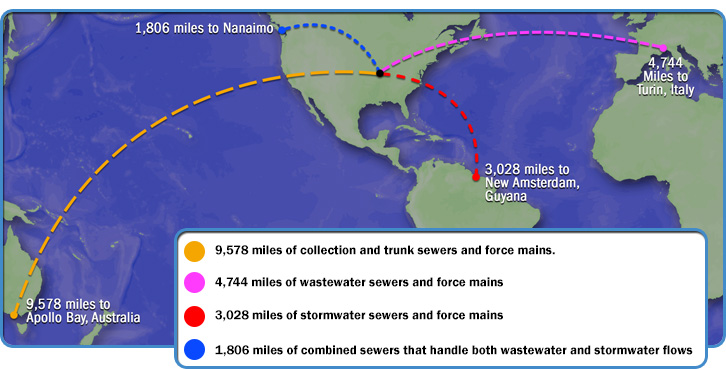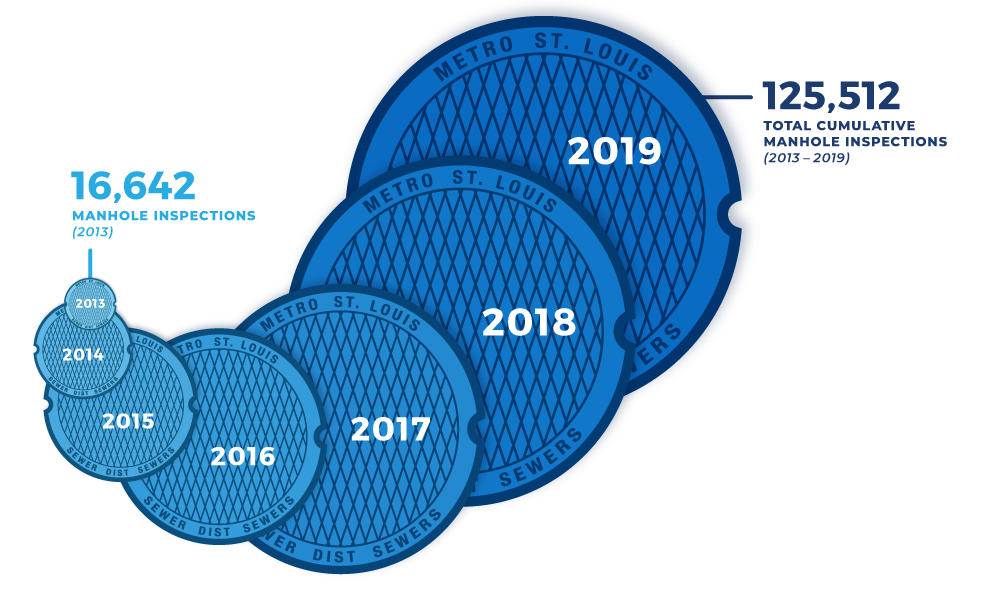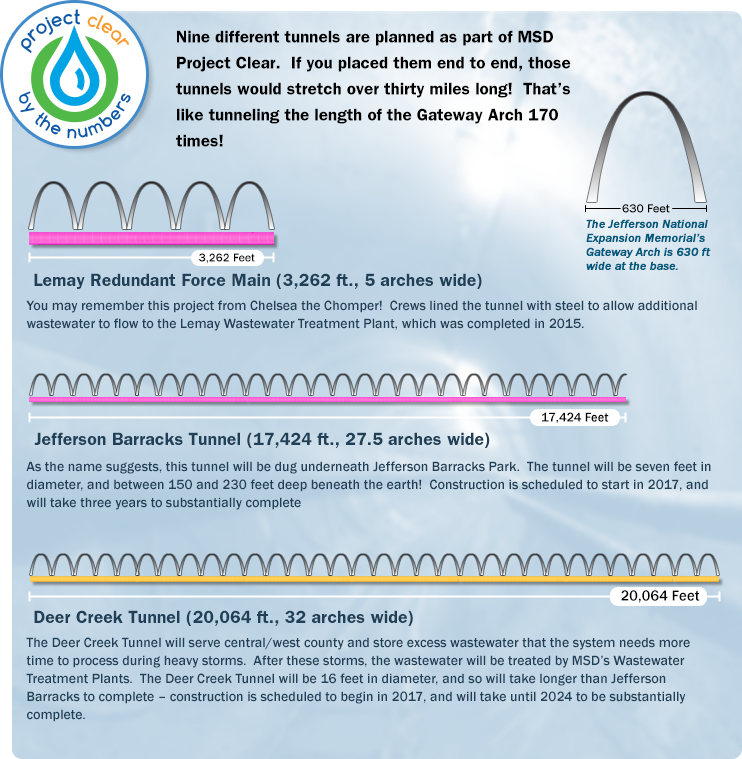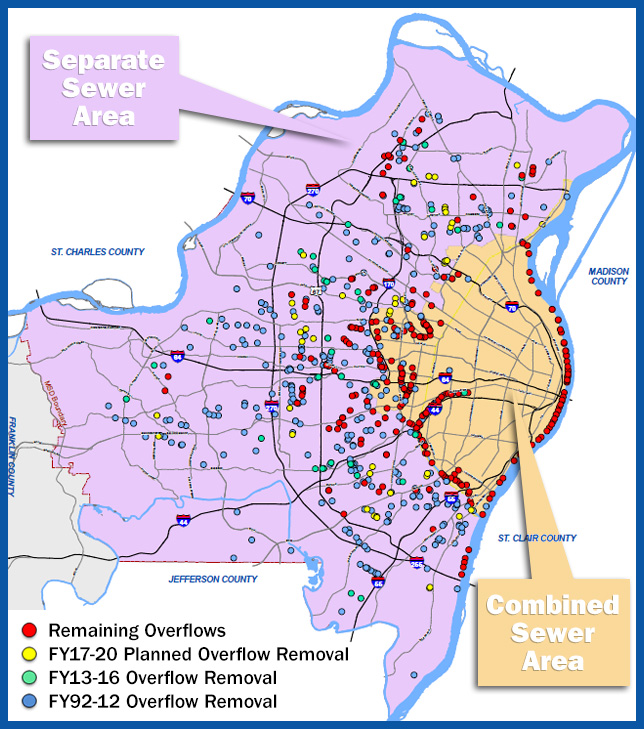MSD Geography
MSD’s system serves nearly 1.3 million people in the Saint Louis City and County area – that takes a lot of pipes!

As of today, MSD owns and maintains 9,578 miles of collection and trunk sewers and force mains, ranging in size from six inches to 29 feet in diameter. That’s enough to reach from the Gateway Arch (west) all the way to Apollo Bay in southwestern Victoria, Australia
The system currently includes approximately 4,744 miles of wastewater sewers and force mains, approximately 3,028 miles of stormwater sewers and force mains , and approximately 1,806 miles of combined sewers that handle both wastewater and stormwater flows.
Check out this page for more interesting facts about the Project Clear Initiative.
Inspecting Manholes
You probably see manhole covers like these every day on your travels around town. Ever thought about what they cover, and just how many there are?

Manholes are important access points to MSD’s sewer lines — lines that serve thousands of homes and businesses across St. Louis City and County. As part of MSD Project Clear, nearly 15,000 manholes will be inspected each year, and will be repaired or replaced as needed.
What is a Manhole?
Here’s a hint – it’s not just the cast iron circular plate you see on sidewalks, in roadways, or sometimes in lawns and parking lots. That cover is just an access point to a hollow column – made out of brick or concrete – that a worker can climb down into to access a wastewater or stormwater pipe. Manholes can be anywhere from three to twenty feet deep, and can access pipes from 4″ to more than 48″ in diameter. Having these access points is crucial in the event of a blockage, break, or backup nearby – because the manhole allows MSD to investigate and clear the issue without digging up the pipe. This means repairs can happen more quickly, and with less above-ground disturbance.
So if you see a manhole, please be sure not to block access to it. MSD has sometimes found entire flower beds on top of their manholes. This takes additional time and work to remove, which is the last thing you want when MSD needs to act quickly to correct a problem in the pipes beneath. Thank you for your help in preserving clear access to these important components of MSD’s system!
Tunnels
Tunnels are an important part of MSD Project Clear’s efforts to handle the wastewater needs of MSD’s service area. Just how many, and how far will they go?

Tunnels are a critical part of MSD Project Clear. These tunnels are designed to handle the wastewater needs of MSD’s service area well into the future by reducing pollution to our waterways and improving the water quality in our communities and neighborhoods. Most of these tunnels will be dug with Tunnel Boring Machines, or TBMs, that grind through the rock – in our region, primarily limestone – to create a space large enough for sections of pipe to be fitted. TBMs range in size according to the project requirements, and travel all over the world digging tunnels like these.
Click here to learn more about our tunnel projects.
Removing and alleviating sewer overflows
MSD Project Clear primarily addresses the sewer overflows that remain from our region’s separate and combined sewers – see how much progress we’ve already made to remove and alleviate these overflows.

Throughout the Metropolitan St. Louis Sewer District’s (MSD) service area, there are hundreds of points where a combination of stormwater and wastewater may discharge into local waterways from the sewer system during moderate to heavy storms. These sewer overflow points act as relief valves when too much stormwater enters the sewer system, and without them, our community could experience thousands of basement backups and/or extensive street flooding. Depending on where sewer overflows are located within MSD’s system, they are classified as constructed separate sewer overflows–or—combined sewer overflows. If an overflow discharges or not is dependent upon a number of factors, including how much rain falls over a given period of time. The result is that not all overflows discharge every time it rains – in fact, some overflows will go months or years without discharging.
The issue of overflows has been a significant focus of MSD’s work for many years. For example, from 1992 to 2012 MSD spent approximately $2.7 billion to eliminate over 38 overflows. Today, our work to address sewer overflows and improve water quality continues in the form of MSD Project Clear, which calls for $4.7 billion in spending over 23-years. MSD Project Clear work began in MSD’s fiscal year 2013 and addresses our community’s wastewater collection and treatment capabilities on a system wide basis. This program is a mammoth undertaking that will benefit St. Louisans-and our environment – for generations to come.
All remaining sewer overflows, indicated with red “dots”, above, will be addressed in the coming years of MSD Project Clear. This page will be updated as additional planning and progress is made.
For more information on sewer overflows and their locations please call (314) 768-6260.

